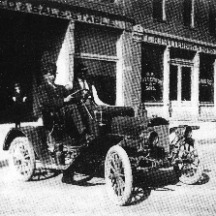In November 2020, Port Of Harlem will celebrate 25 years of publication. As we count down to our birthday, we will republish some of our most popular articles from our print issues. Thanks for subscribing and inviting others to join you in supporting our inclusive, diverse, pan-African publication - - now completely online. We originally published this article in the February - April 2008 print issue.
Henry A. May nearly fell off his chair when he processed the words that came out of his mother’s mouth. “Here was my mother, in 1980, telling me about a family member who made automobiles in the early 1900s,” recounts May in “First Black Autos.” The family member of whom May’s mother spoke was Charles Richard “C.R.” Patterson, founder of the C.R. Patterson and Sons Company of Greenfield, Ohio. A runaway slave with no formal education, C.R. created the first and only documented Black-owned and operated automobile manufacturer in the world.
C.R. was born on a Virginia plantation in April 1833. He assisted the plantation’s blacksmith for 15 years, was adept at shoeing horses, and “Could fix plows, wagons, and buggies.” When he turned 28, C.R. packed a few clothes, some food, and his tools and escaped slavery. After weeks of lurking in forests, trudging through streams, and dodging bounty hunters, C.R. swam across the frigid Ohio River to freedom.
When C.R. reached Greenfield, in 1862, he went to work for a local carriage and coach company, and was soon promoted to shop foreman. When word came of President Lincoln’s abolishment of slavery, Patterson was elated. He had long endured the life of a modern day illegal immigrant, but now he was liberated of the stigma and fear of being a wanted person.
He married Josephine Outz and fathered five children. In 1873, C.R. and James P. Lowe, a White man, explains May, “entered into a partnership and formed their own carriage building company.” Ten years later, when Lowe died, C.R. bought out his partner’s heirs.
By 1905, invention and creativity in the field of transportation were at a fever pitch. Elijah McCoy’s “real McCoy” oil cups were lubricating locomotives. The Wright brothers had taken flight and Patterson dreamed of making “motorized horseless carriages,” but he would not live to see his dream realized. It would be his son, Fred Patterson, who would take the company to the next level.
The First Black Autos
Praising the Past




“Under Fred’s leadership, the C.R. Patterson & Sons Company began to develop the idea that they should be building motorcars as C.R. had envisioned,” explains May. Sure enough, in the fall of 1915, the company realized the founder’s dream and rolled out “their awkward looking, two-door coupe,” known as the “Patterson-Greenfield” onto the streets of Greenfield.
During the next six years, the Patterson Company faced stiff competition from such automotive titans as Ford, Chevrolet, and Chrysler. Henry Ford himself attempted to impede their work by forbidding his train company from delivering auto parts to them.
During the next six years, the Patterson Company faced stiff competition from such automotive titans as Ford, Chevrolet, and Chrysler. Henry Ford himself attempted to impede their work by forbidding his train company from delivering auto parts to them. The company persevered by constantly shifting its business model to fit the customers’ ever-changing needs and by the late 1920s the company had evolved into a full service station: building, servicing, and repairing automobiles.
Postell Patterson, Fred’s son, was now at the helm of the business. He focussed their efforts on building trucks and buses, which were now in vogue. In 1934, the reputation of the Patterson-Greenfield buses drew the attention of Haiti, itself a pioneer being the first nation of enslaved Africans to overthrow and expel its European occupiers in 1804. With all the zeal and craftsmanship inherited from his forefathers, Postell built and delivered the three buses the Haitian government ordered.
Unfortunately, this partnership would prove ironically bittersweet. Haiti embodied CR Patterson’s resilient and pioneering spirit, and was now offering his grandchildren their final lucrative deal. The company, unable to withstand the shifting market and better-funded competition, quickly folded. However, the legacy is left behind remains immortal.
During the next six years, the Patterson Company faced stiff competition from such automotive titans as Ford, Chevrolet, and Chrysler. Henry Ford himself attempted to impede their work by forbidding his train company from delivering auto parts to them.
During the next six years, the Patterson Company faced stiff competition from such automotive titans as Ford, Chevrolet, and Chrysler. Henry Ford himself attempted to impede their work by forbidding his train company from delivering auto parts to them. The company persevered by constantly shifting its business model to fit the customers’ ever-changing needs and by the late 1920s the company had evolved into a full service station: building, servicing, and repairing automobiles.
Postell Patterson, Fred’s son, was now at the helm of the business. He focussed their efforts on building trucks and buses, which were now in vogue. In 1934, the reputation of the Patterson-Greenfield buses drew the attention of Haiti, itself a pioneer being the first nation of enslaved Africans to overthrow and expel its European occupiers in 1804. With all the zeal and craftsmanship inherited from his forefathers, Postell built and delivered the three buses the Haitian government ordered.
Unfortunately, this partnership would prove ironically bittersweet. Haiti embodied CR Patterson’s resilient and pioneering spirit, and was now offering his grandchildren their final lucrative deal. The company, unable to withstand the shifting market and better-funded competition, quickly folded. However, the legacy is left behind remains immortal.
Advertisers | Contact Us | Events | Links | Media Kit | Our Company | Payments Pier
Press Room | Print Cover Stories Archives | Electronic Issues and Talk Radio Archives | Writer's Guidelines




